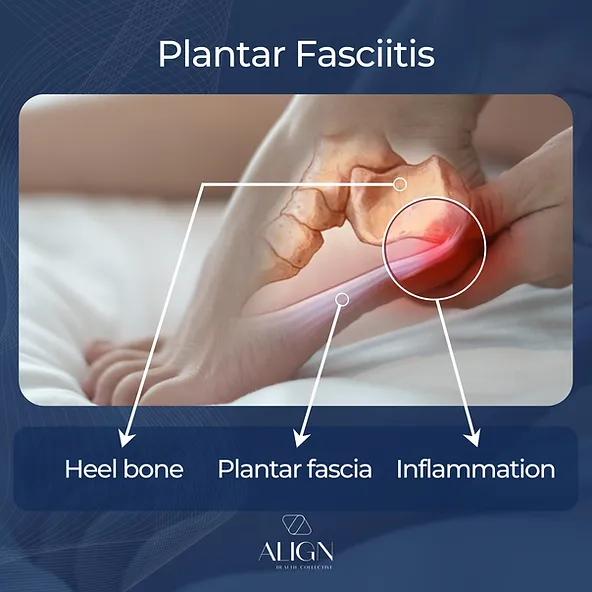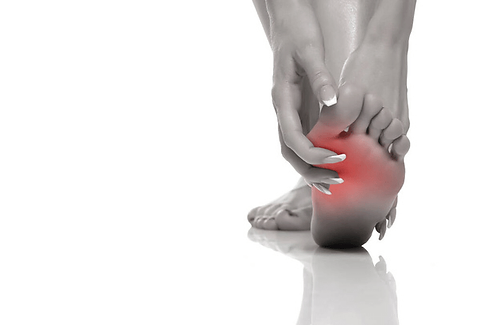If you are experiencing heel pain that is worse in the morning or after prolonged periods of standing or walking, you may be suffering from plantar fasciitis. Plantar fasciitis is a common condition that affects the plantar fascia, a band of tissue that runs along the sole of the foot and attaches at the heel bone.
It is estimated that plantar fasciitis affects up to 10% of the population during their lifetime, with many cases occurring in athletes, runners, and people who spend long periods of time on their feet. If left untreated, plantar fasciitis can lead to chronic heel pain and contribute to other foot and leg problems.

However, with the right treatment plan, many people are able to manage and even overcome their symptoms. At Align Health Collective, our team of experienced podiatrists in Kew offers effective treatment options for plantar fasciitis in Melbourne, Victoria.
In this article, we will discuss the symptoms, causes, and treatment options for plantar fasciitis, as well as the expertise of our podiatry clinic in Melbourne.
What is Plantar Fasciitis?
Plantar fasciitis is a painful condition that is caused by an inflamed plantar fascia. The plantar fascia is a thick band of tissue that runs from the heel to the front of the foot, connecting the heel, arch, and toes.
The plantar fascia’s main function is to support the arch of the foot and act as a shock absorber when we walk, run, or jump. When the plantar fascia is put under too much stress, it can become inflamed. This can cause varying degrees of pain and discomfort in the heel and arch of the foot.
One of the most common symptoms of plantar fasciitis is heel pain that is usually worse first thing in the morning, as soon as you get out of bed, and after periods of rest. Many individuals with plantar fasciitis also describe this particular foot pain as a stabbing and sometimes burning sensation that can feel like a bruise on the bottom of the foot. This pain may improve with activity but worsen again later in the day, and in some cases, the pain may even radiate up into the calf muscles.
There are multiple factors that can contribute to the development of plantar fasciitis. These can include:
- Overuse: Repeatedly placing too much stress on the plantar fascia through activities like running, jumping, or standing for prolonged periods of time can lead to inflammation and irritation.
- Age: Plantar fasciitis is more common in middle-aged individuals.
- Foot mechanics: Certain foot mechanics, such as flat feet or high arches, can put additional strain on the plantar fascia and increase the risk of developing plantar fasciitis.
- Obesity: Being overweight or obese can increase the strain on the plantar fascia, contributing to inflammation and pain. In a 2014 study titled “Plantar Heel Pain“, a strong correlation between obesity and plantar fasciitis has been found. Obesity was observed in 70% of patients who presented with plantar fasciitis.
Symptoms of Plantar Fasciitis
Plantar fasciitis can cause numerous symptoms, each of which can vary in severity. These symptoms can make it difficult to go about your everyday tasks without experiencing pain and discomfort.
Here are some of the most common plantar fasciitis symptoms:
- Heel pain: Pain in the heel, or near the heel, is one of the primary symptoms of plantar fasciitis. This pain may be a sharp or dull sensation, and it is frequently worse in the morning or after extended periods of rest.
- Arch pain: As the plantar fascia supports the arch of the foot, many cases of plantar fasciitis include pain in the arch of the foot as well.
- Stiffness: Stiffness in the foot is another common symptom associated with plantar fasciitis, making it difficult to move the foot and toes.
- Tightness: An inflamed plantar fascia can cause tightness and tension in the bottom of your foot.
- Pain with activity: Plantar fasciitis pain may become worse with activity. This pain is usually worse after or during long periods of standing, walking, or running.
- Pain relief with rest: When you rest or reduce the stress on the foot, this may alleviate plantar fasciitis pain temporarily, but this pain may return with activity.
Plantar fasciitis can become chronic if ignored and left untreated. So, if you are experiencing any of these symptoms, be sure to book a consultation with a qualified health professional.
Causes and Risk Factors of Plantar Fasciitis
Plantar fasciitis can be triggered by overuse, old age, obesity, or the physical structure of your foot. Below are some of the typical causes and risk factors:
- Age: Plantar fasciitis is more common in people over the age of 40.
- Foot mechanics: People with flat feet, high arches, or abnormal walking patterns are more likely to develop plantar fasciitis.
- Obesity: Being obese or having too much excess weight can put extra stress on the plantar fascia, which will increase the risk of inflammation and pain.
- Specific activities: Any activities, exercise, or sports where you stand, run, or jump for a prolonged period of time can put a lot of extra stress on the plantar fascia, increasing the risk of plantar fasciitis.
- Footwear: Wearing shoes with poor arch support, very high heels, stilettos, cheap flip-flops or slippers, or old, worn-out shoes can put extra stress on the plantar fascia and may also negatively affect the Achilles tendon.
- Tight calf muscles: The plantar fascia can be put under increased strain due to tight calf muscles, which may lead to plantar fasciitis.
- Medical conditions: The risk of developing plantar fasciitis may be increased by medical conditions such as arthritis and diabetes.
Plantar Fasciitis Treatment Options
There are various options available for treating plantar fasciitis as well as alleviating related symptoms and pain.
Here are some of the most effective plantar fasciitis treatment options:
Stretching and Exercise for Plantar Fasciitis
Stretching and exercise can help improve flexibility, strength, and mobility in the foot and reduce stress on the plantar fascia. Some effective stretching and exercise techniques for plantar fasciitis include:
- Toe stretches: Sit with your legs straight out in front of you and use a towel to pull your toes towards you. Hold for 15 to 30 seconds and repeat several times.
- Calf stretches: Stand facing a wall with your hands on the wall and one foot behind the other. Lean into the wall until you feel a stretch in your calf. Hold for 15 to 30 seconds and repeat several times.
- Plantar fascia stretches: Sit with your legs straight out in front of you and use a towel to pull your toes towards you. Hold for 15 to 30 seconds and then point your toes away from you and hold for another 15 to 30 seconds.
Orthotics Solutions for Plantar Fasciitis
Orthotics are shoe inserts that can help correct foot mechanics, provide arch support, and reduce stress and strain on the plantar fascia. Custom orthotics are particularly effective for treating plantar fasciitis, as they are tailored to the individual’s specific foot shape and needs.
Medical Treatments for Plantar Fasciitis
In severe cases of plantar fasciitis, medical treatments may be necessary to alleviate symptoms and promote healing. Some effective medical treatments for plantar fasciitis include:
- Cortisone injections: Cortisone injections can help reduce inflammation and pain in the plantar fascia.
- Shockwave therapy: Shockwave therapy uses sound waves to stimulate healing and reduce pain in the plantar fascia.
- Surgery: In rare cases, surgery may be necessary to repair the damaged plantar fascia tissue and relieve pain.

Consultation and Diagnosis Process for Plantar Fasciitis
If you are experiencing symptoms of plantar fasciitis, it’s important to seek professional help for an accurate diagnosis and effective treatment plan as soon as possible. You can consult our podiatry treatment in Oakleigh for specialized care.
Physical Exam and Medical History
During your consultation, your podiatrist will begin by conducting a physical exam of your foot and ankle to check for tenderness, swelling, and range of motion. Your podiatrist will also check whether your pain could be due to a heel spur, damaged ligament, or injured tendon. They will also review your medical history to identify any underlying conditions or contributing factors that may be causing your symptoms.
Diagnostic Tests
After a thorough physical examination of your foot and detailed medical history review, your podiatrist may recommend diagnostic tests and scans to assess your foot in more detail. These can include X-rays, MRIs, or musculoskeletal ultrasounds, which will help identify the extent of the damage to your plantar fascia and rule out other conditions that may be causing your symptoms.
Treatment Plan
Once a diagnosis is made, your podiatrist will work with you to develop a personalised treatment plan based on the severity of your symptoms, your lifestyle, and the underlying cause of your condition. This may include a combination of stretching and exercise programs, custom orthotics, medical treatments such as cortisone injections or shockwave therapy, and lifestyle modifications to reduce stress on the plantar fascia.
Preventing Plantar Fasciitis from Recurring
Plantar fasciitis can flare up whenever the plantar fascia is put under too much stress. This can be caused by numerous changes in lifestyle and/or overall health, including increased physical activity, weight gain, and other medical conditions. However, there are a few things that you can incorporate into your daily routine to help prevent plantar fasciitis from recurring. Remember to always consult a qualified health professional.
Stretching and Exercise
You should continue the stretches and exercises noted above for treatment after your pain has subsided. Sticking to your podiatrist’s recommended stretching and exercise regimen can prevent plantar fasciitis from returning. You can also try the following stretches and exercises to strengthen and stretch the muscles that may be affected by plantar fasciitis. You can do each of these two to three times a day.
- Foot doming: Keep your foot flat on the ground and move your toes back without curling them until you make a “dome” with your foot. You can try this while sitting and when you’re used to doming, you can try it while standing up. Repeat 10 to 15 times on each foot. Don’t do more than three sets of 10 to 15 repetitions on each foot.
- Towel pick-ups: While sitting, put a towel on the floor in front of your foot. Keep your heel on the floor and pick up or lift the towel with your toes, then gently put the towel back on the floor. Repeat 10 times on each foot. Don’t do more than three sets of 10 repetitions on each foot.
- Calf raises: Stand behind a chair and hold it for balance. Keep your legs straight and slowly move your weight onto your toes. Remember to keep you back straight as well. You should feel your calves stretching. Slowly lower your heels back onto the ground. Repeat 10 to 15 times. Feel free to rest in between repetitions. Don’t do more than three sets of 10 per session.
- Step stretches: This is very similar to calf raises, but you’ll stand on a step. You can use stairs, yoga blocks, or anything of similar size that raises you off the ground and is sturdy enough to hold your weight when you stand on it. Make sure you have a chair or table next to you to hold for balance. If you’re on stairs, hold the railing. Keep your legs and back straight and slowly move your weight onto your toes. Then, slowly lower your heels back down past the step until you feel your calves stretching. Try to hold the stretch for 20 to 30 seconds. Repeat two to three times. Rest in between repetitions if necessary. Don’t do more than three sets of two to three repetitions per session.
Exercises to Avoid
As noted previously, you need to avoid putting on excess weight as being overweight or obese will increase the stress on your plantar fascia. But, you still need to exercise. So, to prevent plantar fasciitis from recurring you should try to avoid high-impact sports and exercises that put too much strain on your feet, including:
● Running or jogging without enough rest
● Exercises that involve jumping, such as squat thrusts and burpees
● Tennis, netball, basketball, rugby, and football
● Zumba and aerobics.
Substitute these high-impact activities with low-impact exercise such as swimming, rowing, and low-impact yoga and Pilates. Remember to consult your podiatrist and follow their exercise and stretching recommendations.
Nutrition and Diet
Paying attention to your diet can assist in preventing plantar fasciitis from returning. Adding some anti-inflammatory vitamins and minerals such as vitamins C, D, and K, magnesium, and calcium can help to reduce pain and inflammation.
Moreover, eat foods with high Omega 3 content, as this can help to reduce inflammation as well. On the flip side, you’ll need to avoid food that causes and aggravates inflammation, such as sugar, processed foods, saturated fats, and items made with white flour. Interestingly, avoiding inflammatory foods can also assist with weight loss, which will ultimately reduce the strain and stress on your plantar fascia.
Break Bad Habits
You should follow your podiatrist’s recommendations for shoes and any advice they give on orthotic inserts. In addition, to keep your plantar fasciitis at bay, you’ll also want to avoid wearing high heels and tight shoes. Another bad habit to break, especially in our 21st century fast-paced lives, is not resting enough. However, this is a tricky one because you shouldn’t rest too much either. You’ll need to find a healthy balance that will work for you in your unique circumstance.
At Align Health Collective in Melbourne, VIC, we understand that living with plantar fasciitis can be a challenging and painful experience, which is why we are dedicated to providing our patients with the highest level of care and support throughout the consultation and diagnosis process.
Our committed podiatrists will provide you with compassionate, effective care to help you achieve long-term relief from your symptoms and get back on your feet, pain free. We offer a range of effective treatment options for plantar fasciitis, including stretching and exercise programs, custom orthotics, and medical treatments. All of our treatment plans are personalised and tailored to suit your individual needs. Contact us today to schedule a consultation and take the first step towards healing.
FAQs
Can plantar fasciitis treatment be bulk billed under Medicare?
Yes, plantar fasciitis treatments are part of podiatry treatments which belong to allied health services. With a referral from a General Practitioner, you are eligible for five bulk billed allied health visits per year. For instance, you would be covered for three physio and two podiatry visits per year, or five podiatry visits, etc.
Bulk billing is a payment option that allows Medicare to pay the healthcare provider directly, so patients don’t have to pay out-of-pocket expenses.
Can I permanently get rid of plantar fasciitis?
There is no guaranteed way to permanently get rid of plantar fasciitis, as it can be a chronic condition that requires ongoing management. However, following a comprehensive treatment plan that includes rest, proper footwear, stretching and exercise, orthotics, and other modalities recommended by a healthcare provider can help alleviate pain and prevent recurrent flare-ups.
Is it better to see a podiatrist or orthopaedist for plantar fasciitis?
Both podiatrists and orthopaedists can diagnose and treat plantar fasciitis. However, podiatrists specialise in foot and ankle conditions, while orthopaedists specialise in musculoskeletal conditions throughout the body. Depending on the severity and complexity of the condition, either healthcare provider may be able to provide effective treatment options.
Can an orthopaedic doctor help with plantar fasciitis?
Yes, orthopaedic doctors can help with plantar fasciitis. Podiatrists and orthopaedic doctors may recommend similar treatment options, including rest, ice therapy, stretching and exercise, orthotics, shockwave therapy, and cortisone injections. However, podiatrists may have more specialised expertise in treating foot and ankle conditions.
Can a physiotherapist treat plantar fasciitis?
Yes, physiotherapists can help treat plantar fasciitis. They may use a combination of stretching and exercise, manual therapy, and other modalities to reduce pain and improve mobility. In some instances, they may also work with a podiatrist or orthopaedist to provide a comprehensive treatment plan.
How long can plantar fasciitis last?
Plantar fasciitis can last anywhere from a few weeks to several months or even years. The duration of the condition may depend on factors such as the severity, the effectiveness of treatment, as well as the individual’s overall health, lifestyle, and habits. Plantar fasciitis worsens if left untreated, so early diagnosis and treatment can help to reduce how long it takes to fully recover.
